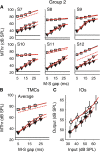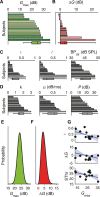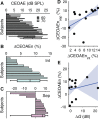Effect of Contralateral Medial Olivocochlear Feedback on Perceptual Estimates of Cochlear Gain and Compression
- PMID: 27550069
- PMCID: PMC5112214
- DOI: 10.1007/s10162-016-0574-8
Effect of Contralateral Medial Olivocochlear Feedback on Perceptual Estimates of Cochlear Gain and Compression
Abstract
The active cochlear mechanism amplifies responses to low-intensity sounds, compresses the range of input sound intensities to a smaller output range, and increases cochlear frequency selectivity. The gain of the active mechanism can be modulated by the medial olivocochlear (MOC) efferent system, creating the possibility of top-down control at the earliest level of auditory processing. In humans, MOC function has mostly been measured by the suppression of otoacoustic emissions (OAEs), typically as a result of MOC activation by a contralateral elicitor sound. The exact relationship between OAE suppression and cochlear gain reduction, however, remains unclear. Here, we measured the effect of a contralateral MOC elicitor on perceptual estimates of cochlear gain and compression, obtained using the established temporal masking curve (TMC) method. The measurements were taken at a signal frequency of 2 kHz and compared with measurements of click-evoked OAE suppression. The elicitor was a broadband noise, set to a sound pressure level of 54 dB to avoid triggering the middle ear muscle reflex. Despite its low level, the elicitor had a significant effect on the TMCs, consistent with a reduction in cochlear gain. The amount of gain reduction was estimated as 4.4 dB on average, corresponding to around 18 % of the without-elicitor gain. As a result, the compression exponent increased from 0.18 to 0.27.
Keywords: click-evoked otoacoustic emissions (CEOAEs); cochlear amplification; contralateral acoustic stimulation; medial olivocochlear reflex (MOCR); temporal masking curve (TMC).
Figures









Similar articles
-
Human medial olivocochlear reflex: effects as functions of contralateral, ipsilateral, and bilateral elicitor bandwidths.J Assoc Res Otolaryngol. 2009 Sep;10(3):459-70. doi: 10.1007/s10162-009-0163-1. Epub 2009 Mar 5. J Assoc Res Otolaryngol. 2009. PMID: 19263165 Free PMC article.
-
Olivocochlear efferents: anatomy, physiology, function, and the measurement of efferent effects in humans.Ear Hear. 2006 Dec;27(6):589-607. doi: 10.1097/01.aud.0000240507.83072.e7. Ear Hear. 2006. PMID: 17086072 Review.
-
Medial olivocochlear efferent reflex inhibition of human cochlear nerve responses.Hear Res. 2016 Mar;333:216-224. doi: 10.1016/j.heares.2015.09.001. Epub 2015 Sep 11. Hear Res. 2016. PMID: 26364824 Free PMC article.
-
Influence of aging on medial olivocochlear system function.Clin Interv Aging. 2014 Jun 10;9:901-14. doi: 10.2147/CIA.S61934. eCollection 2014. Clin Interv Aging. 2014. PMID: 24959071 Free PMC article.
-
Olivocochlear efferents: Their action, effects, measurement and uses, and the impact of the new conception of cochlear mechanical responses.Hear Res. 2018 May;362:38-47. doi: 10.1016/j.heares.2017.12.012. Epub 2017 Dec 21. Hear Res. 2018. PMID: 29291948 Free PMC article. Review.
Cited by
-
Behavioral Measures of Cochlear Gain Reduction Depend on Precursor Frequency, Bandwidth, and Level.Front Neurosci. 2021 Oct 4;15:716689. doi: 10.3389/fnins.2021.716689. eCollection 2021. Front Neurosci. 2021. PMID: 34671236 Free PMC article.
-
The effects of broadband elicitor duration on transient-evoked otoacoustic emissions and a psychoacoustic measure of gain reduction.Res Sq [Preprint]. 2025 Aug 12:rs.3.rs-6753082. doi: 10.21203/rs.3.rs-6753082/v2. Res Sq. 2025. PMID: 40502776 Free PMC article. Preprint.
-
Magnitude of the contralateral efferent olivocochlear effect as a function of the frequency.J Otol. 2022 Apr;17(2):67-71. doi: 10.1016/j.joto.2021.11.004. Epub 2021 Dec 2. J Otol. 2022. PMID: 35949552 Free PMC article.
-
Efferent Control in Musicians: A Review.Audiol Res. 2023 Jan 6;13(1):76-85. doi: 10.3390/audiolres13010007. Audiol Res. 2023. PMID: 36648928 Free PMC article. Review.
-
The effect of broadband elicitor laterality on psychoacoustic gain reduction across signal frequency.J Acoust Soc Am. 2021 Oct;150(4):2817. doi: 10.1121/10.0006662. J Acoust Soc Am. 2021. PMID: 34717476 Free PMC article.
References
Publication types
MeSH terms
Grants and funding
LinkOut - more resources
Full Text Sources
Other Literature Sources
Research Materials
Miscellaneous

